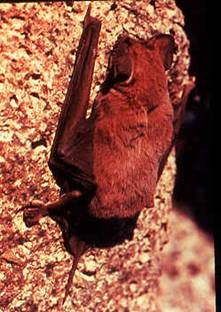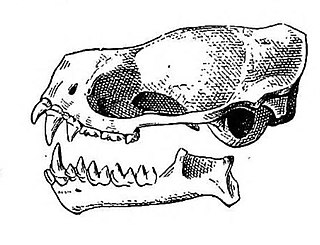
The Molossidae, or free-tailed bats, are a family of bats within the order Chiroptera. The Molossidae is the fourth-largest family of bats, containing about 110 species as of 2012. They are generally quite robust, and consist of many strong-flying forms with relatively long and narrow wings with wrinkled lips shared through their genus. Their strong flying form allows them to fly 60 miles per hour using tail winds and at altitudes over 10,000 feet. This makes them unique among bats, as they are the only bat family that withstands the elevation. They are widespread, being found on every continent except Antarctica. They are typically found in caves, abandoned mines, or tunnels.

The Colombian bonneted bat, also known as Trumbull's bonneted bat, is a bat species found in Bolivia, Brazil, Colombia, French Guiana, Guyana, Peru, Suriname and Venezuela.

The big crested mastiff bat is a species of bat native to Central and South America.
Squalus nasutus, the western longnose spurdog, is a dogfish of the family Squalidae, found on the continental shelf off the northwest and southwest coasts of Western Australia, at depths between 300 and 510 m. Its length is at least 55 cm.
The Sind bat is a species of vesper bat and the only member of the genus Rhyneptesicus. It inhabits forests and arid areas near waterbodies in southwestern Saudi Arabia, Yemen and Oman, around the coast of the Gulf of Oman in southern Iraq and Iran. Isolated populations in southern Pakistan and northwestern Afghanistan occur up to an elevation of 862 m (2,828 ft). Its presence in Bahrain, Qatar and the United Arab Emirates is uncertain.

Hyperolius nasutus is a species of frog in the family Hyperoliidae. Common names include long-nosed reed frog, sharp-nosed reed frog and long reed frog. It is known from northern Angola and northern Botswana, but it presumably occurs more widely. The nominal Hyperolius nasutus was partitioned in 2013 into three cryptic species, the other two being Hyperolius viridis and Hyperolius microps. All these species are members of the so-called Hyperolius nasutus species group, the "long reed frogs".

Eumops nanus is a species of bat found in Central and South America.
Promops davisoni is a species of free-tailed bat in the family Molossidae. It was first described by Oldfield Thomas in 1921. While thought of as a subspecies of the big crested mastiff bat by scientists from roughly 1966 to 2010, morphological and geographical differences between P. davisoni and P. centralis are sufficiently suggestive of another species. P. davisoni is small for its genus, with a forearm length of 47.6 to 52.0 millimetres, and is light or cinnamon brown with distinguishable white bands on its back. P. davisoni is native to the Andes mountain range in Ecuador and Peru. More recently, evidence has been found that P. davisoni resides in the Atacama Desert in Chile.







